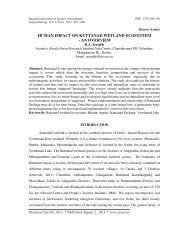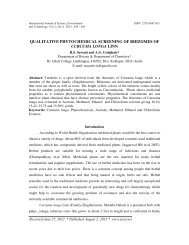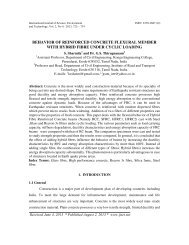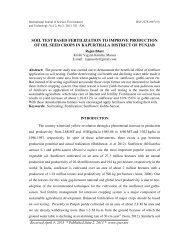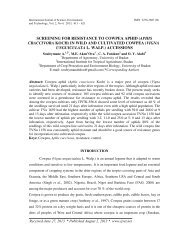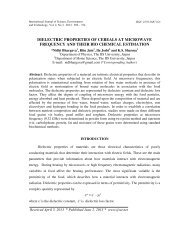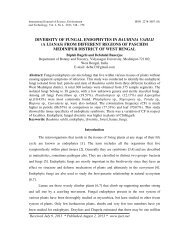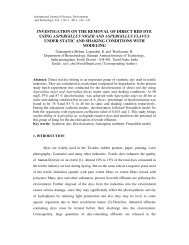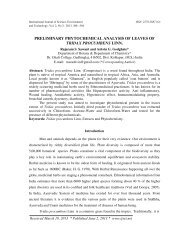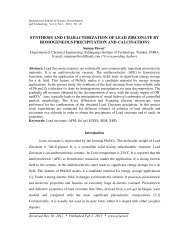on certain derivatives of the i-function of two variables - international ...
on certain derivatives of the i-function of two variables - international ...
on certain derivatives of the i-function of two variables - international ...
Create successful ePaper yourself
Turn your PDF publications into a flip-book with our unique Google optimized e-Paper software.
Internati<strong>on</strong>al Journal <strong>of</strong> Science, Envir<strong>on</strong>ment<br />
and Technology, Vol. 2, No 4, 2013, 772 – 778<br />
ISSN 2278-3687 (O)<br />
ON CERTAIN DERIVATIVES OF THE I-FUNCTION OF TWO<br />
VARIABLES<br />
1<br />
Shantha Kumari K. and 2 Vasudevan Nambisan T.M.<br />
1 Research Scholar, SCSVMV, Kanchipuram and Department <strong>of</strong> Ma<strong>the</strong>matics, P.A. College<br />
<strong>of</strong> Engineering, Mangalore, Karnataka, INDIA<br />
2 Department <strong>of</strong> Ma<strong>the</strong>matics, College <strong>of</strong> Engineering, Trikaripur, Kerala, INDIA<br />
E-mails: 1 skk_ _ abh@rediffmail.com / 2 tmvasudevannambisan@yahoo.com<br />
Abstract: In this paper we establish some differentiati<strong>on</strong> formulas for <strong>the</strong> I-functi<strong>on</strong> <strong>of</strong> <strong>two</strong><br />
<strong>variables</strong> recently defined by Shantha Kumari, et al. in [17]. A number <strong>of</strong> special cases <strong>of</strong> our<br />
results are also discussed.<br />
Keywords: I-functi<strong>on</strong>, Mellin Barnes C<strong>on</strong>tour integral, H-functi<strong>on</strong>.<br />
1. Introducti<strong>on</strong><br />
The well known H-functi<strong>on</strong> <strong>of</strong> <strong>on</strong>e variable, introduced by [5] and studied by<br />
Braaksma [3] c<strong>on</strong>tains as particular cases most <strong>of</strong> <strong>the</strong> comm<strong>on</strong>ly used special functi<strong>on</strong>s <strong>of</strong><br />
applied ma<strong>the</strong>matics. But it does not c<strong>on</strong>tain some <strong>of</strong> <strong>the</strong> important functi<strong>on</strong>s such as <strong>the</strong><br />
Riemann zeta functi<strong>on</strong>s, polylogarithms etc. By dem<strong>on</strong>strating several examples <strong>of</strong> functi<strong>on</strong>s<br />
which are not included in <strong>the</strong> Fox’s H-functi<strong>on</strong>, in 1997, Rathie [16] introduced a new<br />
functi<strong>on</strong> in <strong>the</strong> literature namely <strong>the</strong> “I-functi<strong>on</strong>” which is useful in Ma<strong>the</strong>matics, Physics and<br />
o<strong>the</strong>r branches <strong>of</strong> applied ma<strong>the</strong>matics. The newly defined functi<strong>on</strong> c<strong>on</strong>tains <strong>the</strong><br />
polylogarithms, <strong>the</strong> exact partiti<strong>on</strong> <strong>of</strong> Gaussian free energy model from statistical mechanics,<br />
Feynmann integrals and functi<strong>on</strong>s useful in testing hypo<strong>the</strong>sis from statistics as special cases.<br />
Recently, <strong>the</strong> I-functi<strong>on</strong> introduced by Rathie [16] has found useful applicati<strong>on</strong>s in wireless<br />
communicati<strong>on</strong>s [2]. Motivated by this, very recently, Shantha Kumari et al. [17], introduced<br />
and studied, I-functi<strong>on</strong> <strong>of</strong> <strong>two</strong> <strong>variables</strong> which gives a natural generalizati<strong>on</strong> <strong>of</strong> <strong>the</strong> H-<br />
functi<strong>on</strong> <strong>of</strong> <strong>two</strong> <strong>variables</strong> introduced by Mittal and Gupta [13].<br />
The I-functi<strong>on</strong> <strong>of</strong> <strong>two</strong> <strong>variables</strong> defined and studied by Shantha Kumari et al. [17] is<br />
represented by means <strong>of</strong> <strong>the</strong> double Mellin Barnes c<strong>on</strong>tour integral in <strong>the</strong> following manner.<br />
Received July 9, 2013 * Published August 2, 2013 * www.ijset.net
773 Shantha Kumari. K. and Vasudevan Nambisan T.M.<br />
<br />
<br />
<br />
<br />
<br />
<br />
# $ % & <br />
' ( <br />
! " /<br />
<br />
)<br />
* + <br />
, - . <br />
<br />
0123 4 4 506 738 0638 073)6)7 0 @ A B 6 B 7> E A< B C 6 C ! 7<br />
<br />
> <br />
HI <br />
D<br />
< B # C$ 6> <br />
D<br />
J I) B * 6<br />
8 063 <br />
> <br />
H <br />
D F<br />
I# B$ 6> <br />
J D F<br />
I< B ) C * 6<br />
<br />
> <br />
LI <br />
D<br />
< B & C' 7> <br />
M D<br />
I, B - 7<br />
8 073 <br />
> <br />
LI <br />
D F<br />
& B' 7> <br />
M D F<br />
I< B , C - 7<br />
Also:<br />
• O P O P ;<br />
• Q RB< ;<br />
• an empty product is interpreted as unity ;<br />
0
On Certain Derivatives <strong>of</strong> <strong>the</strong> I-Functi<strong>on</strong> <strong>of</strong> ……… 774<br />
< Z S 3 lie to <strong>the</strong> left <strong>of</strong> \ ] . The o<strong>the</strong>r c<strong>on</strong>tour \^ follows similar c<strong>on</strong>diti<strong>on</strong>s in <strong>the</strong><br />
complex t-plane.<br />
The functi<strong>on</strong> defined by (1.1) is an analytic functi<strong>on</strong> <strong>of</strong> and if<br />
<br />
<br />
<br />
<br />
0Q3b c C c % $ B c " B c + * / d P 0
775 Shantha Kumari. K. and Vasudevan Nambisan T.M.<br />
* r u will mean that <strong>the</strong> functi<strong>on</strong> <strong>of</strong> u in fr<strong>on</strong>t <strong>of</strong> it is first multiplied by u and <strong>the</strong>n <strong>the</strong><br />
product is differentiated with respect to u; * r<br />
t<br />
will mean that <strong>the</strong> operati<strong>on</strong> by * r is repeated<br />
r times.<br />
In this paper for <strong>the</strong> sake <strong>of</strong> brevity we shall use <strong>the</strong> following c<strong>on</strong>tracted notati<strong>on</strong> for<br />
I- functi<strong>on</strong> <strong>of</strong> <strong>two</strong> <strong>variables</strong>.<br />
<br />
x <br />
y z { |<br />
<br />
<br />
} ~ € <br />
where<br />
z stands for 0 3 ,<br />
} stands for 0 ! 3 <br />
0G=N3<br />
{ stands for # $ % , ~ stands for 0) * + 3 <br />
| stands for & ' ( <br />
, stands for 0, - . 3 <br />
3. Main Results<br />
In this secti<strong>on</strong> we have obtained <strong>the</strong> following three differentiati<strong>on</strong> formulas.<br />
Formula 1<br />
* r t ‚u ƒ u „ u „ …<br />
u Ġt <br />
F <br />
F F <br />
‡ u „ <br />
u „ ˆ 0i ‰Š Š
On Certain Derivatives <strong>of</strong> <strong>the</strong> I-Functi<strong>on</strong> <strong>of</strong> ……… 776<br />
\= ‘= f= v ) t<br />
)u w ’u ƒ <<br />
0GqQ3 “ “ 506 738 0638 0730 u „ 3 ] 0 u „ 3^)6)7”<br />
9 ; 9 :<br />
where 506 73 , 8 063 and 8 073 are given by (1.2), (1.3) and (1.4) respectively.<br />
Operating under <strong>the</strong> integral sign, <strong>the</strong> expressi<strong>on</strong> becomes<br />
(3.4)<br />
<<br />
<br />
0GqQ3 “ “•506 738 0638 073 ] ^ <br />
9 ; 9 :<br />
t†<br />
– —0‰ C Š 6 C Š 7 B V3u ƒF„ ]F„ ^†t ” )6)70K=e3<br />
Now it is easy to see that<br />
t†<br />
—0‰ C Š 6 C Š 7 B V3<br />
D<br />
D<br />
0< C ‰ C Š 6 C Š 73<br />
<br />
0< C ‰ B o C Š 6 C Š 73 0K=g3<br />
Using (3.6) in (3.5) and interpreting <strong>the</strong> with <strong>the</strong> help <strong>of</strong> (1.1), <strong>the</strong> result follows.<br />
To prove (3.2), express <strong>the</strong> left hand side using <strong>the</strong> c<strong>on</strong>tour integral (1.1), to obtain<br />
\= ‘= f=<br />
t<br />
> u* r B ˜u ƒ <br />
D<br />
0123 4 4 506 738 0638 0730 u „ 3 ] 0 u „ 3^)6)70K=k3<br />
9 ;<br />
9 :<br />
where 506 73 , 8 063 and 8 073 are given by (1.2), (1.3) and (1.4) respectively.<br />
Operating under <strong>the</strong> integral sign, <strong>the</strong> expressi<strong>on</strong> becomes<br />
<<br />
<br />
0GqQ3 “ “•506 738 0638 073 ] ^ <br />
9 ; 9 :<br />
t<br />
– —‰ B C Š 6 C Š 7u ƒF„ ]F„ ^)6)7”0K=m3<br />
D<br />
t<br />
t<br />
writing > D ‰ B C Š 6 C Š 7 as > š0ƒ†› IFF„ ]F„ ^<br />
D and interpreting with <strong>the</strong><br />
help <strong>of</strong> (1.1), <strong>the</strong> result follows.<br />
The pro<strong>of</strong> <strong>of</strong> (3.3) is same as that <strong>of</strong> (3.2).<br />
4. Special cases<br />
(i) When œ t = 0 in (3.2) we get<br />
0u* r 3 t ‚u ƒ u „ u „ …<br />
š0ƒ†› I F„ ]F„ ^
777 Shantha Kumari. K. and Vasudevan Nambisan T.M.<br />
u ƒ <br />
Ft <br />
Ft Ft ‡ u „ <br />
u „ ˆ 0i ‰Š Š
On Certain Derivatives <strong>of</strong> <strong>the</strong> I-Functi<strong>on</strong> <strong>of</strong> ……… 778<br />
[7] Gupta.K.C., Jain Rashmi and Rajani Agrawal, On existence c<strong>on</strong>diti<strong>on</strong>s for a generalized<br />
Mellin - Barnes type integral, Natl Acad Sci Lett, 30(5,6), 169-172, (2007).<br />
[8] Gupta. K.C. and Mittal P.K., Integrals involving a generalised functi<strong>on</strong> <strong>of</strong> <strong>two</strong> <strong>variables</strong>,<br />
Indian J. Pure Appl. Math. 5, 430-437, (1974).<br />
[9] Goyal. S.P., The H-functi<strong>on</strong> <strong>of</strong> <strong>two</strong> <strong>variables</strong> , Kyungpook Math.J. , 15, no.1, 117-131,<br />
(1975).<br />
[10] Kilbas, A.A. and Saigo, M, H-transforms: Theory and applicati<strong>on</strong>s, Boca Rat<strong>on</strong> -<br />
L<strong>on</strong>d<strong>on</strong> - New York- Washingt<strong>on</strong>, D.C. : CRC Press LLC, (2004).<br />
[11] Luke. Y.L., The Special Functi<strong>on</strong>s and <strong>the</strong>ir Approximati<strong>on</strong>s, Vol. 1, Academic<br />
Press, New York, (1969).<br />
[12] Mathai. A.M., Saxena R.K., Haubold. H.J.: The H - functi<strong>on</strong>, Theory and Applicati<strong>on</strong>s,<br />
Springer, (2009).<br />
[13] Mittal, P.K. and Gupta, K.C.: An integral involving generalized functi<strong>on</strong> <strong>of</strong> <strong>two</strong><br />
<strong>variables</strong>, Proc. Indian Acad. Sci., sect. A. 75, 117-123, (1972).<br />
[14] Nair, V.C. Differentiati<strong>on</strong> formulae for <strong>the</strong> H - functi<strong>on</strong> I, Math. Student, 40A,<br />
74-78, (1972).<br />
[15] Rainville, E.D. Special Functi<strong>on</strong>s, Macmillan Publishers, New York, (1963).<br />
[16] Rathie, Arjun K. A new generalizati<strong>on</strong> <strong>of</strong> generalized hypergeometric functi<strong>on</strong>s, Le<br />
Matematiche Vol. LII. Fasc. II, 297 - 310, (1997).<br />
[17] Shantha Kumari. K, Vasudevan Nambisan, T.M. and Arjun K. Rathie, A study <strong>of</strong> I-<br />
functi<strong>on</strong>s <strong>of</strong> <strong>two</strong> <strong>variables</strong>, arXiv: 1212.6717v1 [math.CV], 30 Dec 2012.<br />
[18] Srivastava. H.M., Gupta K.C., Goyal S.P., The H - functi<strong>on</strong>s <strong>of</strong> <strong>on</strong>e and <strong>two</strong> <strong>variables</strong><br />
with applicati<strong>on</strong>s, South Asian Publishers, New Delhi.(1982).<br />
[19] Vishwa Mohan Vyas and Arjun K. Rathie, A Study <strong>of</strong> I-functi<strong>on</strong> - II, Vijnana<br />
Parishad Anusandhan Patrika, Vol.41, 4, 253-257, (1998).



